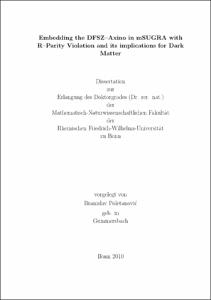Embedding the DFSZ–Axino in mSUGRA with R–Parity Violation and its implications for Dark Matter

Embedding the DFSZ–Axino in mSUGRA with R–Parity Violation and its implications for Dark Matter

| dc.contributor.advisor | Dreiner, Herbert Karl | |
| dc.contributor.author | Poletanović, Branislav | |
| dc.date.accessioned | 2020-04-16T18:25:18Z | |
| dc.date.available | 2020-04-16T18:25:18Z | |
| dc.date.issued | 21.01.2011 | |
| dc.identifier.uri | https://hdl.handle.net/20.500.11811/4913 | |
| dc.description.abstract | We embed the DFSZ axion in supersymmetry with broken R–parity. As Supersymmetry provides hundreds of free parameters we restrict ourselves to the lepton–number violating scenario in minimal supergravity models with baryon-triality B3. In such models the axino is the lighest supersymmetric particle, it is not stable and its mass is kept to be a free parameter. The axino mixes with the three neutrinos and four neutralinos to form eight mass eigenstates. We introduce an appropiate notation, present briefly the full Langrangian and all axino interactions. This also induces a modification of the renormalization group equations which we compute. Based on this preliminary work we calculate all two– and three–body axino decays to Standard Model particles, e.g. leptons and mesons. Depending on the origin of the RPV operator and the mass of the axino we obtain different final state combinations. Taking this into account we study the corresponding decay widths and branching ratios as a function of the superymmetric unification scale parameters as well as the axino mass. We then in particular focus on the implications for axino cold dark matter. We concentrate on the axino energy density in the light of the WMAP data. These analyses are performed in detail at the benchmark point SPS1a. Representative examples are also chosen for benchmark points SPS2 and SPS4. From this we offer a more general conclusion to other benchmark scenarios. | |
| dc.language.iso | eng | |
| dc.rights | In Copyright | |
| dc.rights.uri | http://rightsstatements.org/vocab/InC/1.0/ | |
| dc.subject.ddc | 520 Astronomie, Kartografie | |
| dc.subject.ddc | 530 Physik | |
| dc.title | Embedding the DFSZ–Axino in mSUGRA with R–Parity Violation and its implications for Dark Matter | |
| dc.type | Dissertation oder Habilitation | |
| dc.publisher.name | Universitäts- und Landesbibliothek Bonn | |
| dc.publisher.location | Bonn | |
| dc.rights.accessRights | openAccess | |
| dc.identifier.urn | https://nbn-resolving.org/urn:nbn:de:hbz:5N-24051 | |
| ulbbn.pubtype | Erstveröffentlichung | |
| ulbbnediss.affiliation.name | Rheinische Friedrich-Wilhelms-Universität Bonn | |
| ulbbnediss.affiliation.location | Bonn | |
| ulbbnediss.thesis.level | Dissertation | |
| ulbbnediss.dissID | 2405 | |
| ulbbnediss.date.accepted | 20.12.2010 | |
| ulbbnediss.fakultaet | Mathematisch-Naturwissenschaftliche Fakultät | |
| dc.contributor.coReferee | Nilles, Hans-Peter |
Files in this item
This item appears in the following Collection(s)
-
E-Dissertationen (4077)




